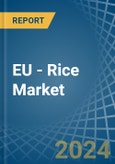1. INTRODUCTION
Making Data-Driven Decisions to Grow Your Business
1.1 REPORT DESCRIPTION
1.2 RESEARCH METHODOLOGY AND AI PLATFORM
1.3 DATA-DRIVEN DECISIONS FOR YOUR BUSINESS
1.4 GLOSSARY AND SPECIFIC TERMS
2. EXECUTIVE SUMMARY
A Quick Overview of Market Performance
2.1 KEY FINDINGS
2.2 MARKET TRENDS
3. MARKET OVERVIEW
Understanding the Current State of The Market and Its Prospects
3.1 MARKET SIZE
3.2 CONSUMPTION BY COUNTRY
3.3 MARKET FORECAST TO 2030
4. MOST PROMISING PRODUCTS
Finding New Products to Diversify Your Business
4.1 TOP PRODUCTS TO DIVERSIFY YOUR BUSINESS
4.2 BEST-SELLING PRODUCTS
4.3 MOST CONSUMED PRODUCT
4.4 MOST TRADED PRODUCT
4.5 MOST PROFITABLE PRODUCT FOR EXPORT
5. MOST PROMISING SUPPLYING COUNTRIES
Choosing the Best Countries to Establish Your Sustainable Supply Chain
5.1 TOP COUNTRIES TO SOURCE YOUR PRODUCT
5.2 TOP PRODUCING COUNTRIES
5.3 COUNTRIES WITH TOP YIELDS
5.4 TOP EXPORTING COUNTRIES
5.5 LOW-COST EXPORTING COUNTRIES
6. MOST PROMISING OVERSEAS MARKETS
Choosing the Best Countries to Boost Your Exports
6.1 TOP OVERSEAS MARKETS FOR EXPORTING YOUR PRODUCT
6.2 TOP CONSUMING MARKETS
6.3 UNSATURATED MARKETS
6.4 TOP IMPORTING MARKETS
6.5 MOST PROFITABLE MARKETS
7. PRODUCTION
The Latest Trends and Insights into The Industry
7.1 PRODUCTION VOLUME AND VALUE
7.2 PRODUCTION BY COUNTRY
7.3 HARVESTED AREA AND YIELD BY COUNTRY
8. IMPORTS
The Largest Importers on The Market and How They Succeed
8.1 IMPORTS FROM 2012-2024
8.2 IMPORTS BY COUNTRY
8.3 IMPORT PRICES BY COUNTRY
9. EXPORTS
The Largest Exporters on The Market and How They Succeed
9.1 EXPORTS FROM 2012-2024
9.2 EXPORTS BY COUNTRY
9.3 EXPORT PRICES BY COUNTRY
10. PROFILES OF MAJOR PRODUCERS
The Largest Producers on The Market and Their Profiles
11. COUNTRY PROFILES
The Largest Markets And Their Profiles
Austria
Belgium
Bulgaria
Croatia
Cyprus
Czech Republic
Denmark
Estonia
Finland
France
Germany
Greece
Hungary
Ireland
Italy
Latvia
Lithuania
Luxembourg
Malta
Netherlands
Poland
Portugal
Romania
Slovakia
Slovenia
Spain
Sweden
LIST OF TABLES
Table 1: Key Findings In 2024
Table 2: Market Volume, In Physical Terms, 2012-2024
Table 3: Market Value, 2012-2024
Table 4: Per Capita Consumption, By Country, 2015-2024
Table 5: Production, In Physical Terms, By Country, 2012-2024
Table 6: Harvested Area, By Country, 2012-2024
Table 7: Yield, By Country, 2012-2024
Table 8: Imports, In Physical Terms, By Country, 2012-2024
Table 9: Imports, In Value Terms, By Country, 2012-2024
Table 10: Import Prices, By Country Of Destination, 2012-2024
Table 11: Exports, In Physical Terms, By Country, 2012-2024
Table 12: Exports, In Value Terms, By Country, 2012-2024
Table 13: Export Prices, By Country Of Origin, 2012-2024
LIST OF FIGURES
Figure 1: Market Volume, In Physical Terms, 2012-2024
Figure 2: Market Value, 2012-2024
Figure 3: Consumption, By Country, 2024
Figure 4: Market Volume Forecast to 2030
Figure 5: Market Value Forecast to 2030
Figure 6: Products: Market Size And Growth, By Type
Figure 7: Products: Average Per Capita Consumption, By Type
Figure 8: Products: Exports And Growth, By Type
Figure 9: Products: Export Prices And Growth, By Type
Figure 10: Production Volume And Growth
Figure 11: Yield And Growth
Figure 12: Exports And Growth
Figure 13: Export Prices And Growth
Figure 14: Market Size And Growth
Figure 15: Per Capita Consumption
Figure 16: Imports And Growth
Figure 17: Import Prices
Figure 18: Production, In Physical Terms, 2012-2024
Figure 19: Production, In Value Terms, 2012-2024
Figure 20: Area Harvested, 2012-2024
Figure 21: Yield, 2012-2024
Figure 22: Production, By Country, 2024
Figure 23: Production, In Physical Terms, By Country, 2012-2024
Figure 24: Harvested Area, By Country, 2024
Figure 25: Harvested Area, By Country, 2012-2024
Figure 26: Yield, By Country, 2012-2024
Figure 27: Imports, In Physical Terms, 2012-2024
Figure 28: Imports, In Value Terms, 2012-2024
Figure 29: Imports, In Physical Terms, By Country, 2024
Figure 30: Imports, In Physical Terms, By Country, 2012-2024
Figure 31: Imports, In Value Terms, By Country, 2012-2024
Figure 32: Import Prices, By Country, 2012-2024
Figure 33: Exports, In Physical Terms, 2012-2024
Figure 34: Exports, In Value Terms, 2012-2024
Figure 35: Exports, In Physical Terms, By Country, 2024
Figure 36: Exports, In Physical Terms, By Country, 2012-2024
Figure 37: Exports, In Value Terms, By Country, 2012-2024
Figure 38: Export Prices, 2012-2024









